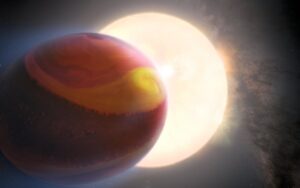
Astronomers have only been able to identify planets orbiting alien stars for about thirty years. Once that first gas giant, 51 Pegasi b, was announced in 1995, astronomers and engineers began looking for ways to not just find these worlds but also study their atmospheres and one day study the place-to-place variations in the light reflecting off their surfaces.
During Hubble’s last servicing mission in 2009, this great orbital observatory was equipped with new instruments able to – in just the right geometries – study the atmospheres of exoplanets.
A world with just the right alignment – WASP-121 b – was discovered in 2015 and then observed by Hubble in 2016, 2018, and 2019. Snuggled up next to its star, which is just a bit larger and warmer than our own Sun, Wasp-121 b orbits and experiences its own version of a year every thirty hours.
According to principal investigator Quentin Changeat, “Our dataset represents a significant amount of observing time for a single planet and is currently the only consistent set of such repeated observations. The information that we extracted from those observations was used to characterize (infer the chemistry, temperature, and clouds) the atmosphere of WASP-121 b at different times. This provided us with an exquisite picture of the planet, changing in time.”
Specifically, the team was able to observe a shift in the position of the exoplanet’s hot spot, changes in the atmosphere’s composition, and evidence the world has quasi-periodic weather patterns. Just like terrestrial meteorologists, the team was able to build weather models that describe how this alien atmosphere works and evolves. Changeat puts this into context, explaining, “Weather on Earth is responsible for many aspects of our life, and in fact, the long-term stability of Earth’s climate and its weather is likely the reason why life could emerge in the first place. Studying exoplanets’ weather is vital to understanding the complexity of exoplanet atmospheres, especially in our search for exoplanets with habitable conditions.”
While we can’t yet travel beyond our solar system’s outermost regions, we can dream, and dreaming gets all the more exciting when we have details describing what actually exists.
